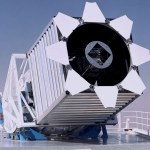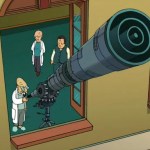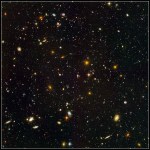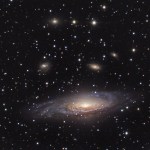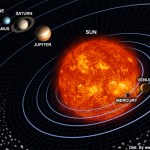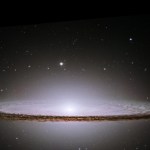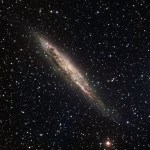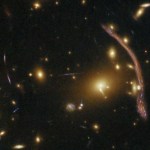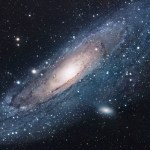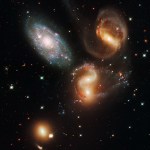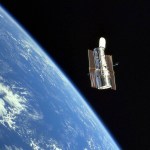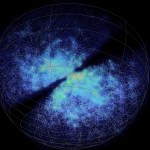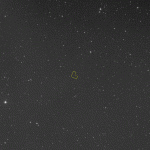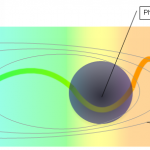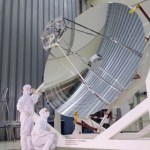Galaxies
Follow humbly wherever and to whatever abyss Nature leads, or you shall learn nothing. -T.H. Huxley
We've spent a little bit of time talking about dark energy, including what we think of it, how we first discovered it, and how we knew that there wasn't just something out there blocking the light. It seems to be the latest abyss that Nature is leading us, so we needed to look beyond the type Ia supernova data and see what else the Universe was telling us.
Image credit: Don Dixon.
So what do we do? First off, we can try to measure how much matter is in the Universe independent of anything…
If you've never been to the Galaxy Zoo website, you have been missing out. The Sloan Digital Sky Survey is a pretty impressive telescope, but the wide-field camera system on it is what's truly amazing. Have you ever seen a telescope that looks like this before?
This telescope surveys a huge area of the sky, taking the highest resolution pictures of tremendous regions of space. We not only get to take a census of a very large region of space, we also get unique views on -- literally -- hundreds of thousands of galaxies. This gives us both the forest and the trees. Sure, I may write more about…
Professor Hubert Farnsworth: I'm sorry, Fry, but astronomers renamed Uranus in 2620 to end that stupid joke once and for all.
Fry: Oh. What's it called now?
Professor Hubert Farnsworth: Urrectum. Here, let me locate it for you.
Fry: No, no, I, I think I'll just smell around a bit over here.
Too bad that Futurama's smell-o-scope doesn't actually exists.
Why is it too bad? Because space is filled with many different types of atoms, including Carbon, Nitrogen, Oxygen, and Hydrogen: the elements essential to terrestrial life. In space, these sometimes appear in isolation, they sometimes appear…
It's hard to believe that until 1929, we were pretty sure that the Universe consisted entirely of our galaxy, and everything else was inside of us.
Hard to believe that you can look at something like this and not think it was another galaxy like our own, isn't it?
Yet when you look in the visible light -- which is all they knew how to do back then -- this is what the pinwheel galaxy (above) looks like through a modern advanced amateur telescope.
Is it really so clear to your naked eye that this image is so different from the one below?
Believe it or not, this image is of a planetary nebula…
The farther backwards you can look, the farther forwards you are likely to see. -- Winston Churchill
Sometimes, we point our most powerful telescopes at the sky, peering as deeply as we possibly can, hoping to shed some light on what the Universe was like oh-so-long ago, as close to the big bang as we can. The Hubble Space Telescope can get us distant galaxies as they were just a few billion years after the big bang.
But Hubble still has never seen one of the elusive, Holy Grails of astronomy: a metal-free star.
You see, immediately after the big bang, the Universe was filled with protons…
I do not know what I may appear to the world; but to myself I seem to have been only like a boy playing on the seashore, and diverting myself in now and then finding a smoother pebble or a prettier shell than ordinary, whilst the great ocean of truth lay all undiscovered before me. --Isaac Newton
Can you imagine what good ol' Sir Isaac would've said, done, and thought if he could've looked up at the stars and seen what we see today?
Image credit: Astronomy Picture of the Day.
Just inspiring, awesome, and yes, this was all undiscovered to him and subsequent scientists for centuries. The…
Seed Magazine (which I've written for) has just put out a space slideshow: Traveling Through Time and Stars.
Michael Benson gives an account -- in words and pictures -- of a journey outwards, from nearby stars to nebulae to other galaxies to clusters of galaxies. The pictures alone are worth having a look at.
Beautiful? I don't know that that even begins to describe it, but it certainly helps give me a great perspective on what these different regions look like.
The idea of zooming out and looking at things on larger and larger scales really appeals to me. In fact, I think the slideshow…
It's only natural to wonder why things are the ways that they are. Take a look at our Solar System, for example.
A central bulge with planets, moons, and whatnot moving in a disc around it. Is this the way things have to be? My friend Rich, a chemist, asks:
It seems that all the objects in our solar system orbit the sun in nearly the same plane. Why is that? Why doesn't the solar system have spherical symmetry?
In particular, Rich wants to know why our Solar System doesn't look more like this:
Our Solar System is definitely not shaped like a sphere; it definitely is a bulge at the center…
You're sweet as a honey bee
But like a honey bee stings
You've gone and left my heart in pain
All you left is our favorite song
The one we danced to all night long
It used to bring sweet memories
Of a tender love that used to be
Now it's the same old song
But with a different meaning
Since you been gone --The Four Tops
Those of you who've been with me since the start of our current series on Dark Matter, including parts I, II, III, and 3.5, know that I'm a big proponent of dark matter. I think, based on everything that we know, that it is the simplest, easiest, and most likely explanation for…
Many of you saw the pictures I posted Monday of colliding galaxy clusters. These pictures were spectacular, because they not only show galaxy clusters less than 200 million years after a collision (which is short, cosmically), they also show where the mass lies (traced in blue) and where the X-ray emitting areas are (pink). You get pictures like this one from the Bullet Cluster:
This one from MACS J0025:
And this one from Abell 520:
This is what happens when clusters collide, the normal matter gets separated from the dark matter! Let's tell you how.
Some normal matter is packed together in…
Deep into the darkness peering,
long I stood there, wondering, fearing,
Doubting, dreaming dreams no mortal ever dared to dream before.
-Edgar Allen Poe, The Raven
Gazing out into the dark abyss of the night sky, stars, galaxies, and clusters shine like tiny islands of light against the blackness of deep space. Trillions upon trillions of protons and neutrons fuse together in stars across the Universe, producing all of this light, and decorating the sky above.
But, as we learned in part one of this series, the starlight that we see only accounts for 2% of all the matter that gravity tells us…
Gravitational lensing happens when a cluster of galaxies happens to be directly between us and an even more distant galaxy. The light from these distant galaxies gets warped into arcs and, oftentimes, multiple images. This shot from the new Hubble camera shows exactly what I'm talking about:
Well, there are hundreds, if not thousands of these known galaxies stretched into multiple images. It's only a matter of time before we see one of these in a lensed galaxy:
Supernova! But what's amazing about this is that if we have multiple images, we'll only see the supernova go off in one of them!…
Andromeda, also known as M31, is the nearest large galaxy to us. At "only" 2 million light-years away, it gives us the best chance to study another spiral galaxy besides our own. I get particularly impressed by the high resolution images we can get, since it's so close to us. Andromeda looks like this in visible light:
And it looks like this in the ultra-violet:
But recently, a few very, very high-resolution pictures were taken, woven together to create a mosaic, and released to the public. The Ultraviolet light one -- made by the Swift satellite -- just came out today, but I thought I'd…
Perhaps my favorite of the new Hubble pictures is this one of Stephan's Quintet (and click here for the 1000 pixel wide version):
It's so stunning that it was chosen as today's Astronomy Picture of the Day. But yesterday, I got a very interesting question to go along with it:
These galaxies are far away, and so we're looking at them in the past. What do they look like today, and are there still five of them?
This is a great question. First off, looking at the image, some of you will count only four galaxies. That's because there are two galaxies that are in the process of merging. You can…
Remember saying goodbye to Hubble's old camera, WFPC2? This servicing mission was months ago, now, so perhaps you've forgotten about this 19 year old telescope.
Well, the new camera, WFC3, is finally ready to make its debut. Plans include surveying the Kuiper Belt, looking at newly forming planets, better measuring dark energy, and a new, improved Ultra Deep Field of the distant Universe.
But, as always, the images are what do it for me. Take Stephan's Quintet, a group of five galaxies close together. Regular telescope? Go, and click to enlarge:
Not bad. But one of the first pictures that…
Ever wonder what it would look like if you took about 100,000 nearby large (i.e., Milky Way sized and larger) galaxies, reduced each one to a point, and mapped them? Well, at Swinburne University of Technology in Australia, they did this, from the point of view of where we are in the Universe. We are the Milky Way, the one dot dead center in this image. Take a look, and click to enlarge:
Does it make you feel insignificant? Or does it make you feel like you're a part of something wondrous? Or both? However it makes you feel, I hope you enjoy looking at it!
It wasn't all that long ago that I wrote a five-part series on Hubble's old camera, WFPC2. I call it "The Camera that Changed the Universe." Part 1 focused on Hubble showing us just how deep, rich, and full of wonder our Universe is. Let's remember how this happened.
The first thing we did was take a patch of sky that was relatively empty. No bright stars, no large galaxies or clusters, no planetary nebulae, just a little tiny patch of black, empty sky.
And then we point Hubble at it. And what do we do? We sit there. And wait. Collecting tiny, miniscule amounts of light. First, for minutes…
Last week, we began talking about understanding the size of the Universe, and we continued this week with some information on distances and motion in the Universe. This brings us to my favorite application, which leads to the Hubble expansion:
Redshift. You see, whenever an atom or molecule emits light, it gives off that light at a very few particular wavelengths. For instance, if you have hydrogen, you'll always get light at wavelengths of 656 nanometers (red), 486 nm (cyan), 434 nm (indigo), 410 nm (violet), and 397 nm (on the border of violet/ultraviolet):
Now there are three things --…
I get a certain question every so often, and it's one of the most difficult questions any cosmologist faces. Today, I try to tackle it. It goes something like this:
If the Universe is 13.7 billion years old, and nothing can go faster than the speed of light, how is it that we see things that are 46.5 billion light years away?
First off -- and I want to clarify this -- everything in this question is legit.
1.) The Universe is 13.7 billion years old. There are small errors there -- no one would be surprised if it was 13.5 billion or 14.0 billion years old -- but it's definitely not 12 billion…
Just a few weeks ago, the Herschel Telescope was launched into space and successfully deployed. Herschel is larger than the Hubble Space Telescope, but instead of measuring visible light, it measures far-infrared light.
This means that, when you look at any object in the Universe, the Hubble Space Telescope sees (mostly) visible light, or light between 400 and 700 nanometers. What gives off visible light? Stars, mostly, as well as some types of heated gas and dust. On the other hand, the light that Herschel sees is much cooler, between 55,000 and 672,000 nanometers.
Longer wavelengths mean…

